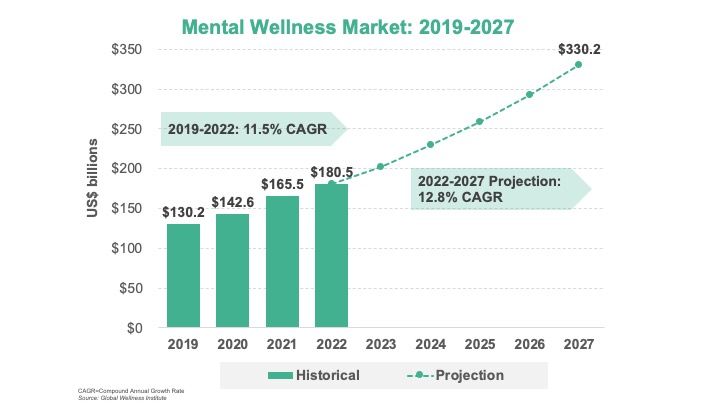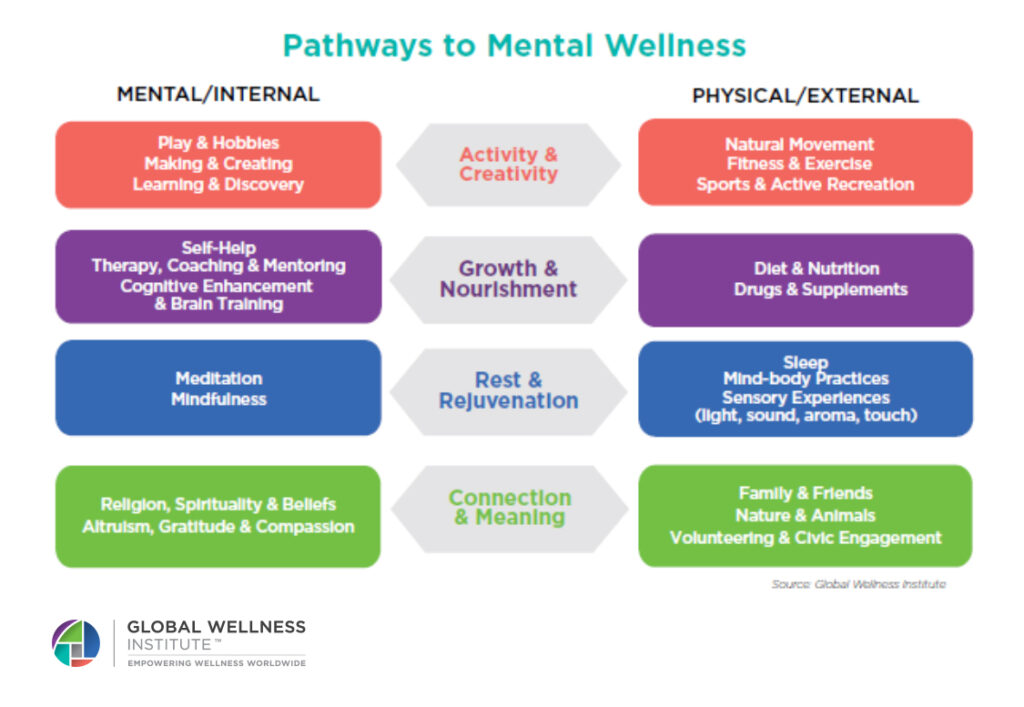Understanding GWI’s Mental Wellness Economy Data
(A market that will grow from $181 billion in 2022 to $330 billion by 2027)
In November 2020, the Global Wellness Institute (GWI) released Defining the Mental Wellness Economy, which was the first ever study to clearly define mental wellness as separate from mental health, and to define and quantify the mental wellness industry. Mental wellness was most recently measured by GWI as a $181 billion global industry in 2022. In conjunction with the release of our new Mental Wellness Policy Toolkit, our data feature for June focuses on the background and context for GWI’s economic data on the mental wellness sector. We provide an overview of our mental wellness time series data for 2019-2022 (and projecting forward to 2027), along with some insights on how to interpret and use the data – specifically focusing on what the data do, and do not, capture.
How and why did GWI start gathering data on mental wellness?
GWI’s research team has been measuring the global wellness economy and its underlying sectors since 2014. However, mental wellness was not measured or added to our wellness economy framework until 2020, when it became the eleventh sector or “bubble” in our wellness economy construct. Why did it take so long for us to include mental wellness in the global wellness economy? In order to answer that question, it is important to understand our rigorous methodology for codifying and quantifying all of the wellness economy sectors.
Every sector included in GWI’s wellness economy framework must meet several conditions. Since our data focuses on economic measurements (i.e., buying and selling things in the marketplace), there needs to be a robust or growing consumer market for products and services in the sector. Before we can measure something, we need to be able to define the sector, or put boundaries around what it does and does not include. And, we need to have access to global data streams that will allow us to make credible estimates of the market size across 200+ countries and regions.
An exploding marketplace for mental wellness. Consumer and societal interest in mental wellness has grown and evolved over several decades, alongside the growth of wellness in general. Most mental wellness modalities have roots in ancient times, but activities like meditation and self-help started taking off among mainstream Western consumers since the 1960s and 1970s, fueled by books, television, and celebrity “influencers.” However, it was not until the last 10 years that a definable consumer marketplace for mental wellness products and services has emerged – and interest especially exploded during the COVID-19 pandemic.
As consumer participation in meditation, mind-body practices, self-help, coaching, plant-based drugs, and all kinds of other mental wellness modalities has proliferated, businesses have responded by launching innumerable classes, apps, tech solutions, gadgets, products, accessories, and more to support these practices. In a very short time span, practices that were once done in ashrams, spiritual centers, informal groups, or at home have become big business. Reflecting this trend, the GWI research team decided in 2020 that the consumer marketplace for mental wellness services and products was robust enough – and distinct enough from other wellness sectors – to be able to measure it and add it to the wellness economy.
Defining mental wellness and its difference from mental health. In spite of our growing interest in and need for mental wellness, our understanding of what it is has always been vague. People associate mental wellness with many different types of activities, from meditating or listening to music, to taking a bubble bath or talking to a friend. Most people would agree that mental wellness is different than happiness, but very few of us can elaborate precisely how the two are different. Sometimes the term mental wellness is used synonymously with mental health or mental wellbeing, two terms that are also not well-defined.
In 2020, the GWI research team spent a full year developing our definition of mental wellness, as well as elaborating how this definition connects with the economic marketplace for mental wellness products and services. In our definition, mental wellness is an internal resource that helps us to think, feel, connect, and function; it is an active process that helps us to build resilience, grow, and flourish. Our definition builds upon well-established theories from psychology and academic literature, and it frames them in a language that is more understandable to consumers, businesspeople, and policymakers.
Importantly, mental wellness is not just the absence of a mental health condition. It is a key resource that can help us to build resilience, manage symptoms associated with mental health disorders (or help protect against their development), and find meaning and purpose in life.
Measuring mental wellness as an economic sector. GWI’s measurement of mental wellness as an economic sector encompasses consumer expenditures on four subcategories of mental wellness-related products, services, and experiences:
- Senses, spaces, & sleep;
- Brain-boosting nutraceuticals & botanicals;
- Self-improvement; and
- Meditation & mindfulness.
Our mental wellness industry figures are estimates made by the GWI research team. We draw upon a wide variety of secondary data sources as a baseline, and we develop original country-level estimates based upon our own economic models and our extensive knowledge of adjacent wellness sectors. Key sources consulted include: Euromonitor International, World Bank, United Nations, World Health Organization, U.S. National Center for Complementary and Integrative Health, International Coaching Federation, Statista, Frost & Sullivan, Arcview Group/BDS Analytics, Prohibition Partners, and a wide variety of country-specific and industry-specific organizations, databases, publications, and media sources. Our research efforts have also benefitted from the deep global experience and insights of the GWI Mental Wellness Initiative.
For more details on mental wellness as a concept and as an economic sector (including definitions of the four subsectors), see GWI’s 2020 report, Defining the Mental Wellness Economy.
Mental wellness has been one of the fastest-growing sectors in the wellness economy.
The mental wellness sector has grown by 11.5% annually from 2019-2022, reaching a market size of $181 billion globally in 2022. By comparison, global GDP grew by only 4.8% annually during this same time period (based on IMF data).

Mental wellness is one of the few wellness sectors that continued an upward growth trajectory during the COVID-19 pandemic, fueled by consumers desperately seeking out products, services, and solutions to help them cope with the immense stresses they faced during this global crisis. Wherever we look, financial, physical, and social disruptions from economic shocks, environmental disasters, socio-political conflicts, health concerns, employment pressures, etc. are threatening our wellbeing. People around the world are facing rising rates of anxiety, depression, stress, burnout, and social isolation. All of these trends are fueling ongoing interest in mental wellness practices and growing out-of-pocket spending on related products and services. GWI estimates that the mental wellness sector will grow at a robust rate of 12.8% annually through 2027, reaching a market size of $330 billion.
For more data on the mental wellness sector, see the most recent edition of GWI’s Global Wellness Economy Monitor.
There are numerous opportunities to support mental wellness for all populations, and these sit outside of the consumer marketplace.
Users of GWI’s mental wellness data need to understand the limitations of economic data and interpret it with caution. Just because we have identified four subsectors as comprising the “mental wellness economy” DOES NOT mean that these are the most important or most effective practices for pursuing mental wellness. The subsectors, products, and services we measure are merely the things that have become commercialized products and services in the marketplace and that are proactively marketed by businesses as being related to mental wellness. In addition, while there is a growing body of evidence on the benefits of many mental wellness practices (e.g., meditation, arts activities, yoga, etc.), there is also a dizzying array of products in the marketplace that lack evidence on their effectiveness – making it challenging for consumers to make informed choices. Therefore, users of our data should take caution not to misinterpret the numbers or to infer that the data are capturing everything available to us to support our mental health and wellbeing.
Importantly, there are so many things we can do to support our mental wellness that are not acts of consumption (such as spending time in nature, joining a spiritual community, being with friends, or making/enjoying art and music) and, therefore, cannot be monetized by businesses or measured in economic terms. In GWI’s extensive research and analysis of this topic, we have segmented the multi-dimensional strategies for mental wellness into four main pathways (see figure below). Some of these pathways (specifically, Growth & Nourishment and Rest & Rejuvenation) overlap with our mental wellness data, while the others exist outside of the commercial marketplace.

Mental unwellness has been a growing public health crisis for some time. The mental wellness pathways outlined above offer a path forward to help ease our mental health crisis and increase wellbeing for all. We do not need to spend money in order to access these strategies. And yet, so many populations around the world lack awareness of mental wellness and lack access to mental wellness resources and opportunities. To expand access, we need policies that address the common barriers experienced across nations and cultures. We also need public investment and public-private collaborations to increase knowledge and provide more opportunities to promote mental wellness. For this reason, GWI has developed a new Mental Wellness Policy Toolkit, as part of our ongoing Wellness Policy Series. The toolkit offers a wide variety of policy recommendations that focus on promoting education, raising awareness, and improving community support systems. These can be pursued by many stakeholder groups, including governments, local communities, business leaders, health professionals, and the research community, to holistically support the mental wellness of all populations.
For more information on mental wellness policy and expanding access to all populations, see GWI’s newly released Mental Wellness Policy Toolkit.

























































